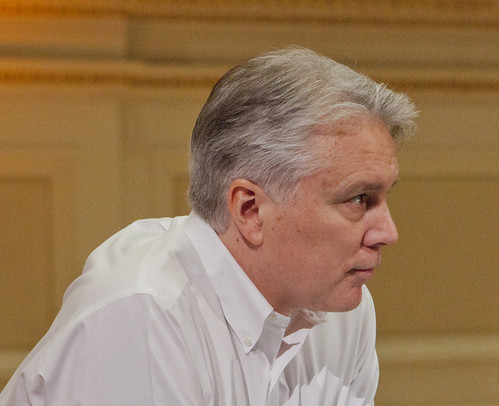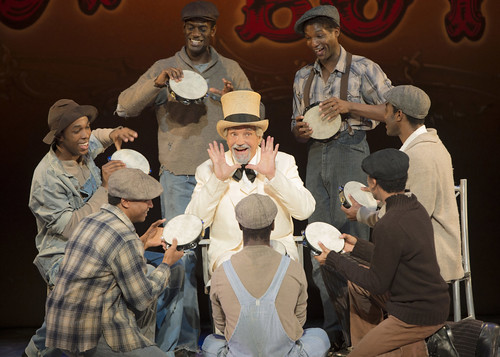David Thompson on racism, history and making it all sing
 David Thompson is the Tony-nominated book writer of The Scottsboro Boys, one of the final collaborations of the legendary team of John Kander and Fred Ebb. The new musical is part of the American Conservatory Theater season. Below: Hal Linden (center) as the Interlocutor and the cast of The Scottsboro Boys. Photos courtesy of American Conservatory Theater
David Thompson is the Tony-nominated book writer of The Scottsboro Boys, one of the final collaborations of the legendary team of John Kander and Fred Ebb. The new musical is part of the American Conservatory Theater season. Below: Hal Linden (center) as the Interlocutor and the cast of The Scottsboro Boys. Photos courtesy of American Conservatory Theater
David Thompson is the first to admit that regardless of the show itself, he would do anything to work with John Kander, Fred Ebb and Susan Stroman, three major theater artists with whom he had collaborated on And the World Goes 'Round, the 1987 revival of Flora the Red Menace and Steel Pier.
"Working with John, Fred and Stro has been an extraordinary gift and privilege," Thompson says on the phone from his home in Millburn, N.J. "They come from a kind of theater that really understands the craft of telling a story and telling it well. We begin every work session with 'what if' and just throw ideas out there. Working with them, they've always found a way to inspire me to do better and bigger work – not in a grand way – their talent is so huge that everybody they work with brings the best possible work they can to the table."
Around 2000, Kander and Ebb, the legendary duo behind Cabaret and Chicago, gathered Thompson and Stroman to start talking about a new show. They knew they wanted to work on a true story, and then they narrowed it down to the tale of the Scottsboro Boys, nine young African-American men accused of raping two white women in Alabama circa 1931. It wasn't exactly a story, with its astonishing racism and repeated miscarriage of justice, that you would think about turning into a musical. But that's where the genius of Kander and Ebb come in.
"John and Fred know that you must entertain your audience and tell an interesting story," Thompson says. "And then you cannot pull back from the way you've decided to tell that story. The minute you soften your approach, you cheapen your approach. You might think you're making it less difficult, but really you're making it worse."
As the creative team began to piece together what would become the musical The Scottsboro Boys, the creative team latched on to the idea of using the form of a minstrel show to tell the story. "We never looked back," Thompson says. "That allowed us to take a story extremely rooted in racism and mix in an art form also rooted in racism, then smash them together. When you think about it, you have two seminal American forms: the trial and the minstrel show. What Stro has done as director and choreographer is take this form and tip it on its head."
As for the notion that this was a story that demanded its characters sing, Thompson says these boys, who ranged in age from 12 to 19, are classic musical characters standing up and saying they matter and they have something to say.
"The sing because they will not be marginalized," he explains. "If you look at what really happened to them, these boys were out riding the rails looking for work. They got caught up in this story and stumbled into the national spotlight. They did fight to make themselves matter even though they were ultimately forgotten. We were interested in that, in bringing them back and making their voices heard."
Scottsboro was a huge hit in runs at the Vineyard Theatre off Broadway in New York and at the Guthrie Theater in Minneapolis. Then the show went to Broadway, where it ran for only 49 performances and managed to pick up 12 Tony Award nominations without winning a single one. But that wasn't the end of the story. The show, with the original creative team in tow, minus Fred Ebb, who sadly died in 2004, is making several stops at regional theaters around the country, including San Francisco's American Conservatory Theater.
Regional audiences, unlike the more commercially minded Broadway audience, have been responding enthusiastically to the show. The reason, Thompson says, is that regional audiences arrive as willing participants. "I don't think audiences demand as much as they can from the theater they see," he says. "There's so much more we as artists should be bringing to an audience, and with this show, I think we're doing that. Broadway can be an extraordinary place for theater full of extraordinary talent. But it's not the only place theater can live."
The whole Scottsboro journey has been a wild one, from the death of Ebb to protestors in front of the Broadway theater (apparently the idea of a minstrel show didn't sit well with them, even though they hadn't actually seen the show), but through it all, Thompson says the affection among the creative team and a shared belief in telling this true story kept the project moving forward.
"One of the most rewarding moments in anything I've ever done came on closing night in New York," Thompson recalls. "We had been talking to the cast backstage and were late getting to our seats. The audience was seated, and Stro and I were heading to the back of the theater. But John always likes to watch from the audience, so there he was coming down the aisle, trying to be as discreet as possible. But the audience recognized him and started clapping, then stood up. It was unbelievable. They knew they were watching a legend of the American theater just trying to find his sit. For me, it was a friend and a collaborator being recognized, and moments just don't get any better."[bonus interview]I talked to John Kander and Susan Stroman for a feature in the San Francisco Chronicle. Read the story here.FOR MORE INFORMATIONThe Scottsboro Boys continues an extended run through July 22 at American Conservatory Theater, 415 Geary St., San Francisco. Tickets are $20-$95 (subject to change). Call 415-749-2228 or visit www.act-sf.org.
